Applied Communication 3: Workforce Diversity and Discrimination Report
VerifiedAdded on 2020/04/01
|7
|1105
|33
Report
AI Summary
This report, titled "Applied Communication 3", focuses on the benefits of a diverse workforce and the importance of managing cultural differences within an IT firm. It explores the recruitment of Maori and Indian candidates, considering their qualifications, experiences, and cultural backgrounds. The report highlights two types of workplace discrimination outlined by the Human Rights Commission and discusses the Treaty of Waitangi's relevance. Furthermore, it addresses the role of the Institute of IT Professionals (IITP) in New Zealand and suggests guidelines for managers to promote inclusion and prevent discrimination. The conclusion emphasizes the positive impact of a diverse workforce and the need for proactive management to ensure fair treatment of all employees. The report draws on references to support its findings.
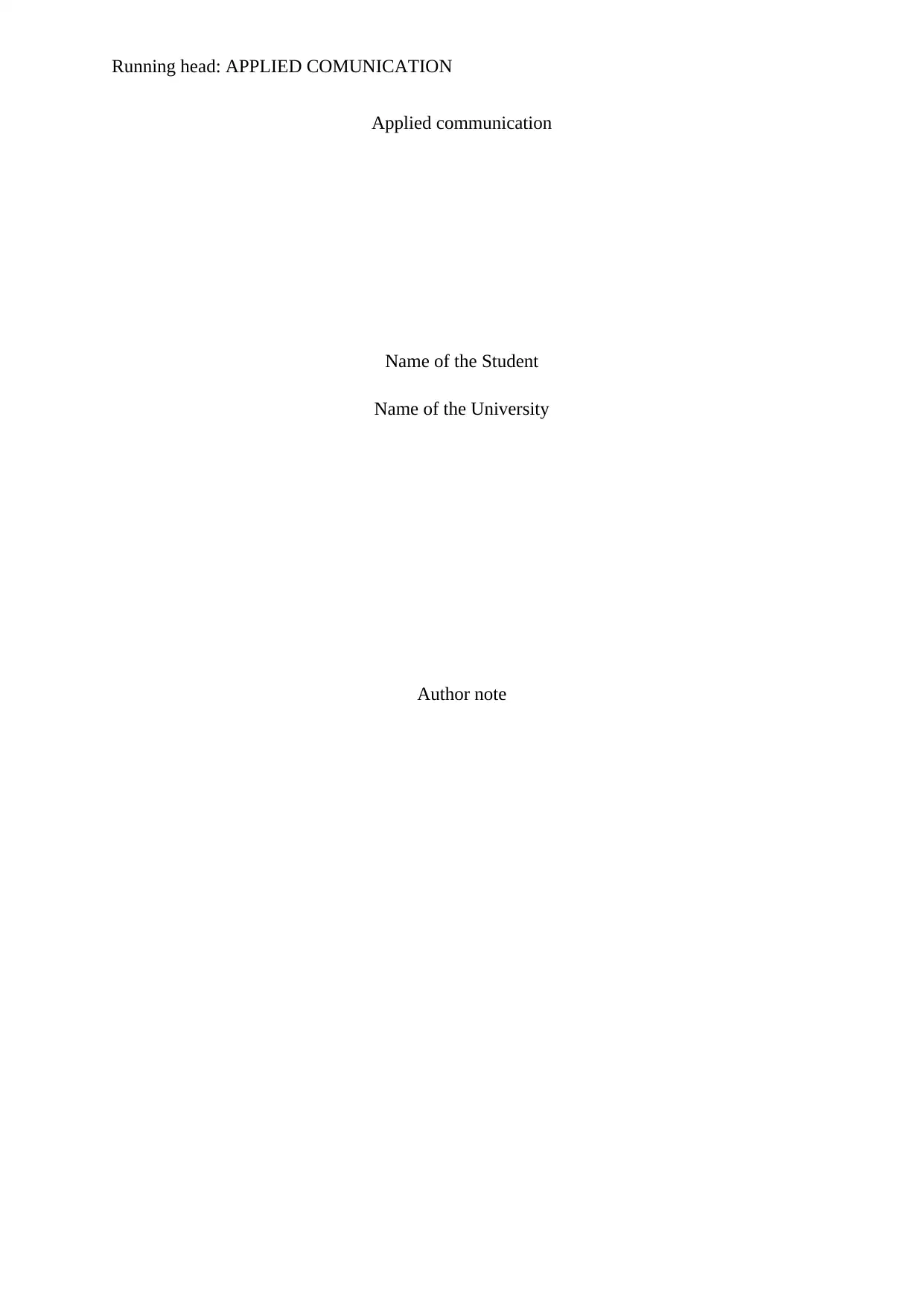
Running head: APPLIED COMUNICATION
Applied communication
Name of the Student
Name of the University
Author note
Applied communication
Name of the Student
Name of the University
Author note
Paraphrase This Document
Need a fresh take? Get an instant paraphrase of this document with our AI Paraphraser

1APPLIED COMMUNICATION
Executive summary
The purpose of this report is to draw attention to the presence of employees from various
cultures in the workforce is actually an asset for any company. The report further sheds light
on the types of discriminations people from different ethnicities may face in the workplace,
and how the managers need to be aware of that and deal with it with care.
Executive summary
The purpose of this report is to draw attention to the presence of employees from various
cultures in the workforce is actually an asset for any company. The report further sheds light
on the types of discriminations people from different ethnicities may face in the workplace,
and how the managers need to be aware of that and deal with it with care.
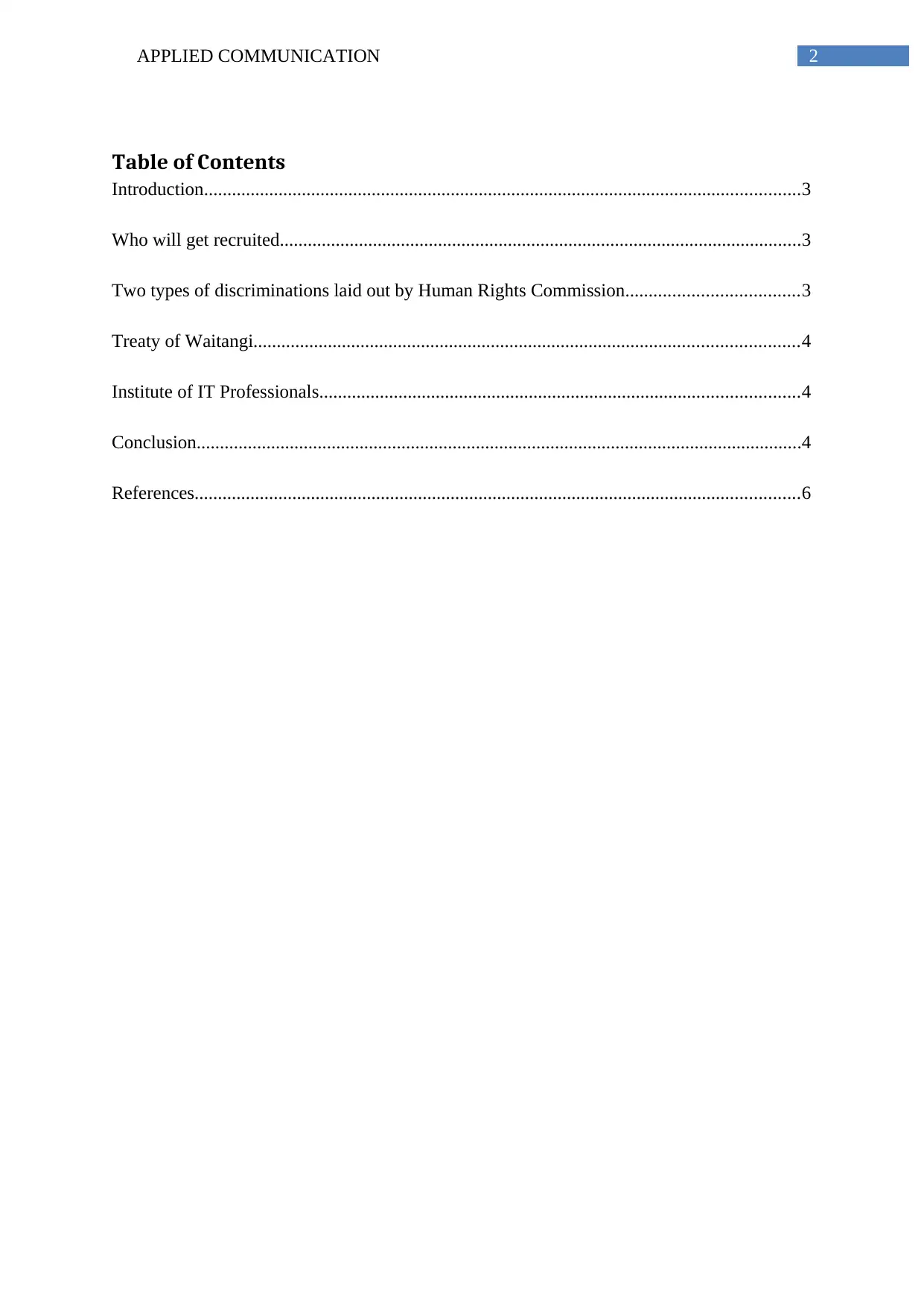
2APPLIED COMMUNICATION
Table of Contents
Introduction................................................................................................................................3
Who will get recruited................................................................................................................3
Two types of discriminations laid out by Human Rights Commission.....................................3
Treaty of Waitangi.....................................................................................................................4
Institute of IT Professionals.......................................................................................................4
Conclusion..................................................................................................................................4
References..................................................................................................................................6
Table of Contents
Introduction................................................................................................................................3
Who will get recruited................................................................................................................3
Two types of discriminations laid out by Human Rights Commission.....................................3
Treaty of Waitangi.....................................................................................................................4
Institute of IT Professionals.......................................................................................................4
Conclusion..................................................................................................................................4
References..................................................................................................................................6
⊘ This is a preview!⊘
Do you want full access?
Subscribe today to unlock all pages.

Trusted by 1+ million students worldwide
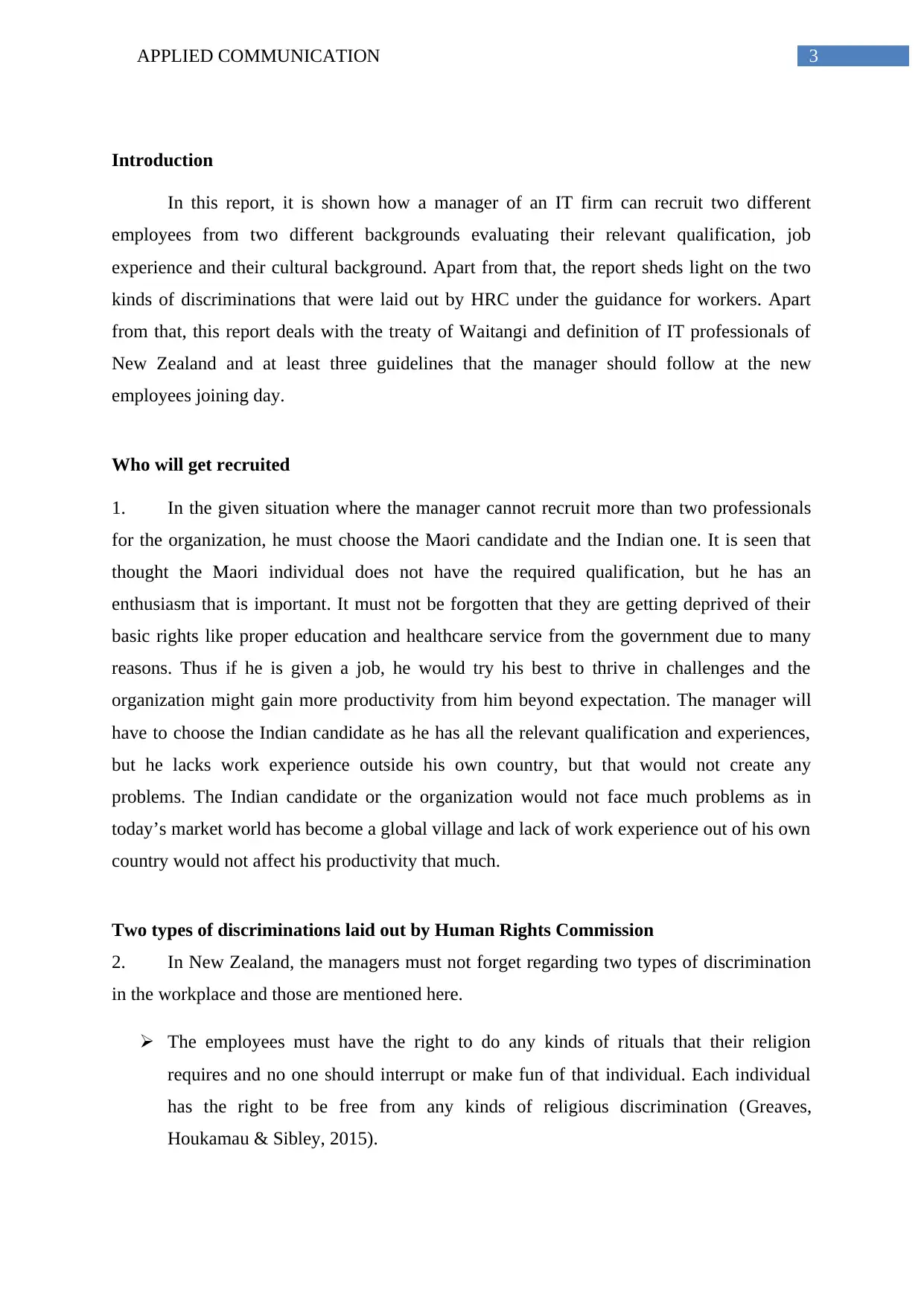
3APPLIED COMMUNICATION
Introduction
In this report, it is shown how a manager of an IT firm can recruit two different
employees from two different backgrounds evaluating their relevant qualification, job
experience and their cultural background. Apart from that, the report sheds light on the two
kinds of discriminations that were laid out by HRC under the guidance for workers. Apart
from that, this report deals with the treaty of Waitangi and definition of IT professionals of
New Zealand and at least three guidelines that the manager should follow at the new
employees joining day.
Who will get recruited
1. In the given situation where the manager cannot recruit more than two professionals
for the organization, he must choose the Maori candidate and the Indian one. It is seen that
thought the Maori individual does not have the required qualification, but he has an
enthusiasm that is important. It must not be forgotten that they are getting deprived of their
basic rights like proper education and healthcare service from the government due to many
reasons. Thus if he is given a job, he would try his best to thrive in challenges and the
organization might gain more productivity from him beyond expectation. The manager will
have to choose the Indian candidate as he has all the relevant qualification and experiences,
but he lacks work experience outside his own country, but that would not create any
problems. The Indian candidate or the organization would not face much problems as in
today’s market world has become a global village and lack of work experience out of his own
country would not affect his productivity that much.
Two types of discriminations laid out by Human Rights Commission
2. In New Zealand, the managers must not forget regarding two types of discrimination
in the workplace and those are mentioned here.
The employees must have the right to do any kinds of rituals that their religion
requires and no one should interrupt or make fun of that individual. Each individual
has the right to be free from any kinds of religious discrimination (Greaves,
Houkamau & Sibley, 2015).
Introduction
In this report, it is shown how a manager of an IT firm can recruit two different
employees from two different backgrounds evaluating their relevant qualification, job
experience and their cultural background. Apart from that, the report sheds light on the two
kinds of discriminations that were laid out by HRC under the guidance for workers. Apart
from that, this report deals with the treaty of Waitangi and definition of IT professionals of
New Zealand and at least three guidelines that the manager should follow at the new
employees joining day.
Who will get recruited
1. In the given situation where the manager cannot recruit more than two professionals
for the organization, he must choose the Maori candidate and the Indian one. It is seen that
thought the Maori individual does not have the required qualification, but he has an
enthusiasm that is important. It must not be forgotten that they are getting deprived of their
basic rights like proper education and healthcare service from the government due to many
reasons. Thus if he is given a job, he would try his best to thrive in challenges and the
organization might gain more productivity from him beyond expectation. The manager will
have to choose the Indian candidate as he has all the relevant qualification and experiences,
but he lacks work experience outside his own country, but that would not create any
problems. The Indian candidate or the organization would not face much problems as in
today’s market world has become a global village and lack of work experience out of his own
country would not affect his productivity that much.
Two types of discriminations laid out by Human Rights Commission
2. In New Zealand, the managers must not forget regarding two types of discrimination
in the workplace and those are mentioned here.
The employees must have the right to do any kinds of rituals that their religion
requires and no one should interrupt or make fun of that individual. Each individual
has the right to be free from any kinds of religious discrimination (Greaves,
Houkamau & Sibley, 2015).
Paraphrase This Document
Need a fresh take? Get an instant paraphrase of this document with our AI Paraphraser

4APPLIED COMMUNICATION
No employees can be discriminated by their ethnicities. In today’s world, it is seen
that people from various ethnicities are working peacefully in workplaces. In today’s
world, it is seen that various culture is present in the workplace and that is seen as an
advantage as then various kinds of ideas can be seen and that would benefit the
organization (Muriwai, Houkamau, & Sibley, 2015).
In this part of the report, it is evident that the manager’s choice of recruiting the Maori
and the Indian would be appropriate, as this would certainly avoid these forms of
discrimination in the workplace.
Treaty of Waitangi
3. The treaty of Waitangi is the treaty signed in the year of 1840 that stated that the
British Government of New Zealand recognizes that Maori people of New Zealand who are
the inhabitants of the land own the land, and that treaty allowed the British government to
purchase land in New Zealand. In short, it can be said that this treaty declared the British
sovereignty over New Zealand (Betony & Yarwood, 2013). It is a matter of fact that Maori
people were always deprived from their basic rights and thus recruiting a Maori individual
would help them a lot.
Institute of IT Professionals
4. IITP or Institute of IT Professionals is a non-profit organization of New Zealand , and
the organization promotes education and makes it sure that a high level of professional
practice is present among all the IT professionals.
On the first day of some employees, the manager should not forget three main things
and those are the induction training must take place, the employees must be told what the
organization expects from them and what they can expect from the organization. These are
very important as the induction training allows the newly joined employees to brush up their
skills. In addition, the information regarding what the organization expect from them and
what the employees can expect from the organization is very important to build a healthy
communication between the management and the employees (Benseman, 2013).
No employees can be discriminated by their ethnicities. In today’s world, it is seen
that people from various ethnicities are working peacefully in workplaces. In today’s
world, it is seen that various culture is present in the workplace and that is seen as an
advantage as then various kinds of ideas can be seen and that would benefit the
organization (Muriwai, Houkamau, & Sibley, 2015).
In this part of the report, it is evident that the manager’s choice of recruiting the Maori
and the Indian would be appropriate, as this would certainly avoid these forms of
discrimination in the workplace.
Treaty of Waitangi
3. The treaty of Waitangi is the treaty signed in the year of 1840 that stated that the
British Government of New Zealand recognizes that Maori people of New Zealand who are
the inhabitants of the land own the land, and that treaty allowed the British government to
purchase land in New Zealand. In short, it can be said that this treaty declared the British
sovereignty over New Zealand (Betony & Yarwood, 2013). It is a matter of fact that Maori
people were always deprived from their basic rights and thus recruiting a Maori individual
would help them a lot.
Institute of IT Professionals
4. IITP or Institute of IT Professionals is a non-profit organization of New Zealand , and
the organization promotes education and makes it sure that a high level of professional
practice is present among all the IT professionals.
On the first day of some employees, the manager should not forget three main things
and those are the induction training must take place, the employees must be told what the
organization expects from them and what they can expect from the organization. These are
very important as the induction training allows the newly joined employees to brush up their
skills. In addition, the information regarding what the organization expect from them and
what the employees can expect from the organization is very important to build a healthy
communication between the management and the employees (Benseman, 2013).
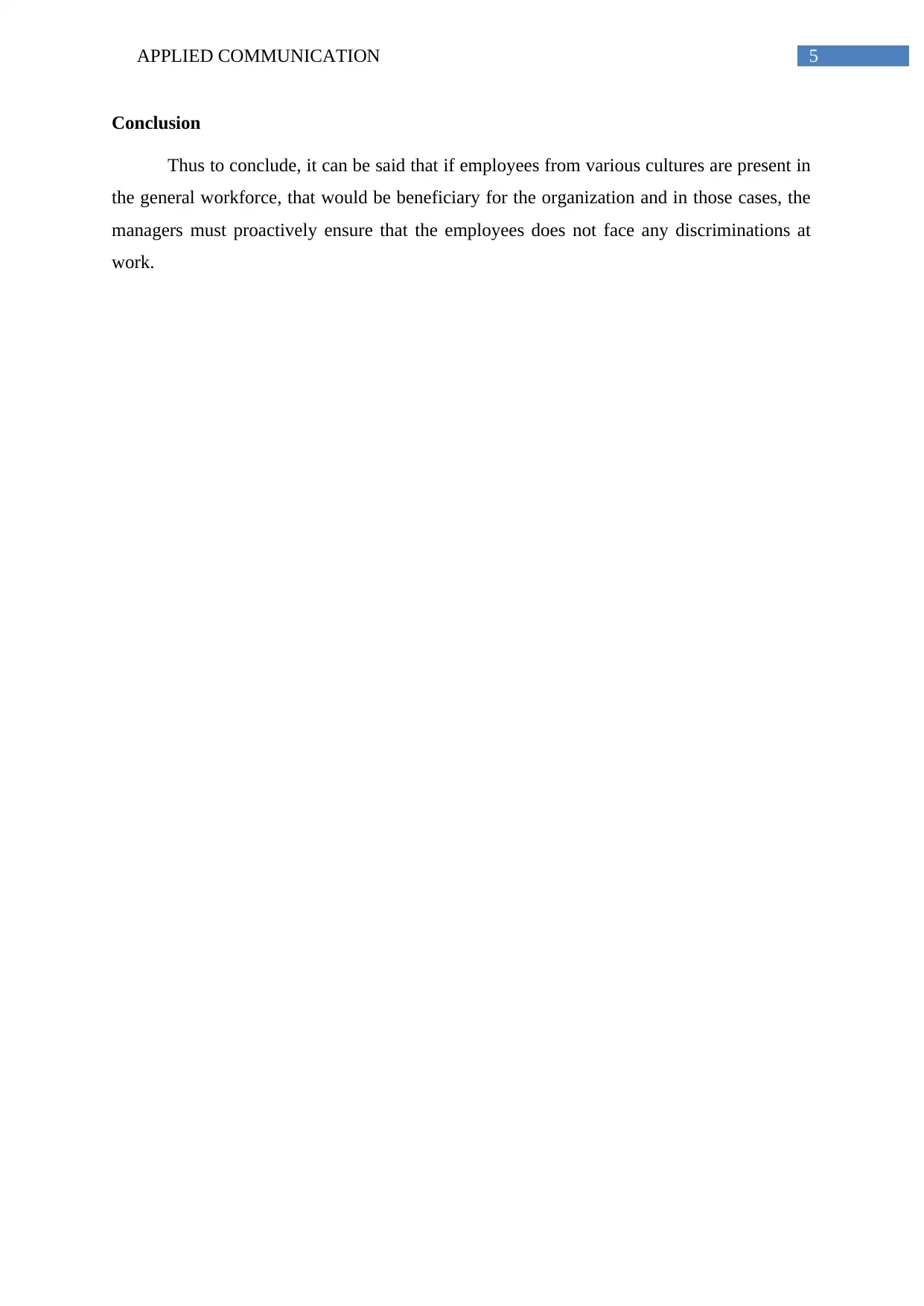
5APPLIED COMMUNICATION
Conclusion
Thus to conclude, it can be said that if employees from various cultures are present in
the general workforce, that would be beneficiary for the organization and in those cases, the
managers must proactively ensure that the employees does not face any discriminations at
work.
Conclusion
Thus to conclude, it can be said that if employees from various cultures are present in
the general workforce, that would be beneficiary for the organization and in those cases, the
managers must proactively ensure that the employees does not face any discriminations at
work.
⊘ This is a preview!⊘
Do you want full access?
Subscribe today to unlock all pages.

Trusted by 1+ million students worldwide
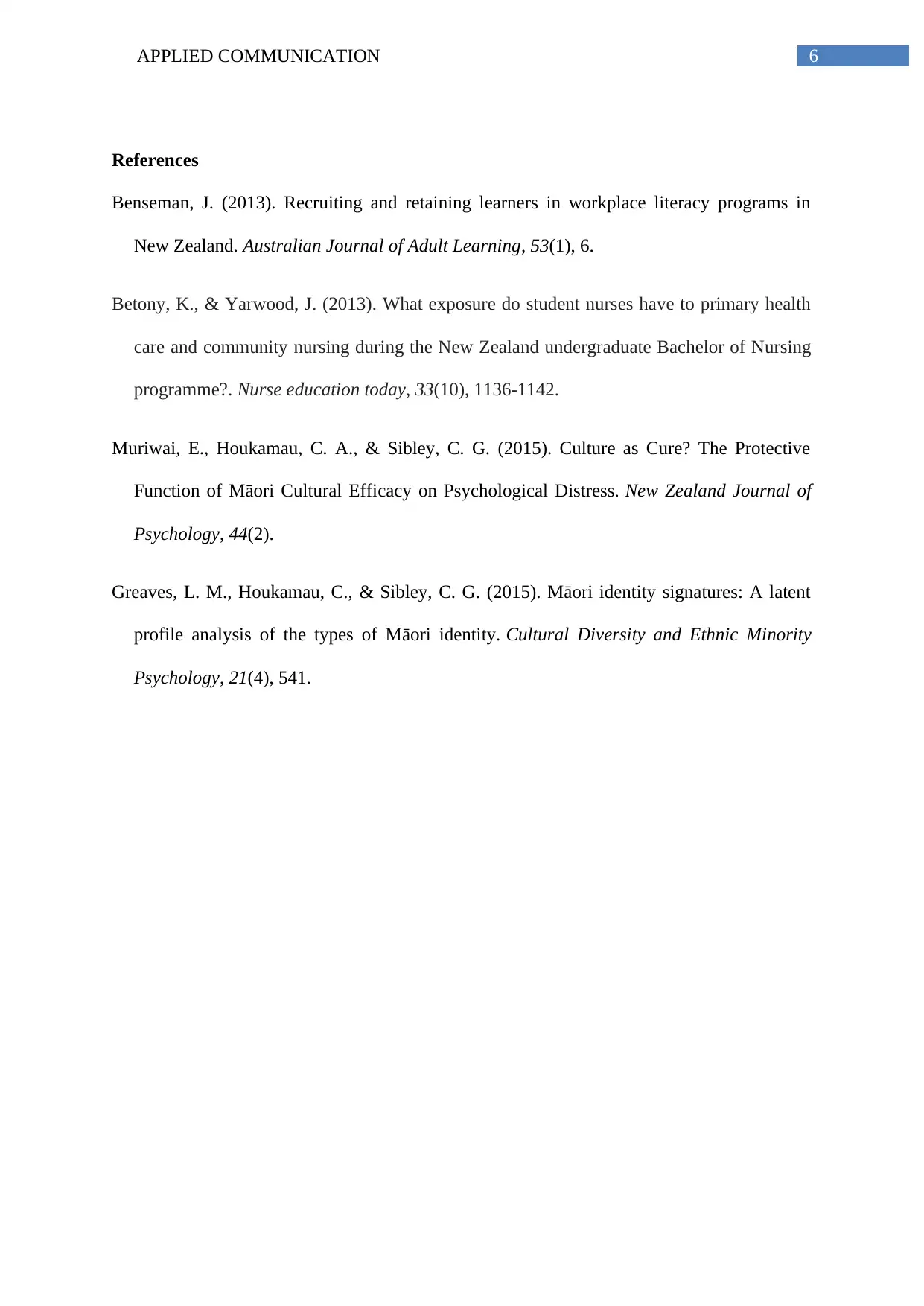
6APPLIED COMMUNICATION
References
Benseman, J. (2013). Recruiting and retaining learners in workplace literacy programs in
New Zealand. Australian Journal of Adult Learning, 53(1), 6.
Betony, K., & Yarwood, J. (2013). What exposure do student nurses have to primary health
care and community nursing during the New Zealand undergraduate Bachelor of Nursing
programme?. Nurse education today, 33(10), 1136-1142.
Muriwai, E., Houkamau, C. A., & Sibley, C. G. (2015). Culture as Cure? The Protective
Function of Māori Cultural Efficacy on Psychological Distress. New Zealand Journal of
Psychology, 44(2).
Greaves, L. M., Houkamau, C., & Sibley, C. G. (2015). Māori identity signatures: A latent
profile analysis of the types of Māori identity. Cultural Diversity and Ethnic Minority
Psychology, 21(4), 541.
References
Benseman, J. (2013). Recruiting and retaining learners in workplace literacy programs in
New Zealand. Australian Journal of Adult Learning, 53(1), 6.
Betony, K., & Yarwood, J. (2013). What exposure do student nurses have to primary health
care and community nursing during the New Zealand undergraduate Bachelor of Nursing
programme?. Nurse education today, 33(10), 1136-1142.
Muriwai, E., Houkamau, C. A., & Sibley, C. G. (2015). Culture as Cure? The Protective
Function of Māori Cultural Efficacy on Psychological Distress. New Zealand Journal of
Psychology, 44(2).
Greaves, L. M., Houkamau, C., & Sibley, C. G. (2015). Māori identity signatures: A latent
profile analysis of the types of Māori identity. Cultural Diversity and Ethnic Minority
Psychology, 21(4), 541.
1 out of 7
Related Documents
Your All-in-One AI-Powered Toolkit for Academic Success.
+13062052269
info@desklib.com
Available 24*7 on WhatsApp / Email
![[object Object]](/_next/static/media/star-bottom.7253800d.svg)
Unlock your academic potential
Copyright © 2020–2025 A2Z Services. All Rights Reserved. Developed and managed by ZUCOL.



